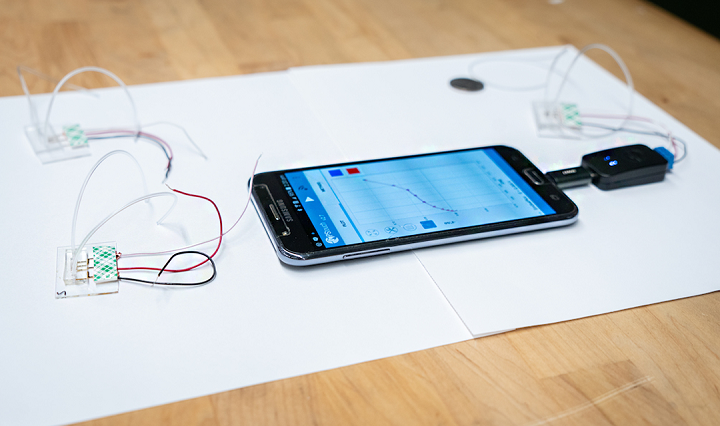3D Printed Sensor Detects COVID-19 Antibodies in 10 Seconds
Ever since the COVID-19 pandemic began in early 2020, 3D printing has been making major headlines, whether the technology is being used to make PPE, ventilators, and nasal swabs, or researchers are trying to come up with a vaccine…or a test.
The latter is what a multidisciplinary team of researchers from Carnegie Mellon University (CMU), the University of Pittsburgh, and the University of Pittsburgh Medical Center (UPMC) have been working on, using the patented Aerosol Jet process by Optomec to create a novel, inexpensive sensor that takes about ten seconds to identify COVID-19 antibodies. The team’s sensitive test is said to be the fastest known COVID-19 antibody test available, and it’s all due to an electrochemical reaction and 3D printing.
Rahul Panat, Associate Professor of Mechanical Engineering at CMU, researches different AM techniques for producing biosensing devices and human-computer interfaces, and led the team that developed the sensor. He worked with Shou-Jiang Gao, professor of microbiology and molecular genetics at the University of Pittsburgh and leader of the Cancer Virology Program at UPMC Hillman Cancer Center, and Azahar Ali, a postdoctoral researcher in Panat’s Advanced Manufacturing and Materials Lab, was the lead author of the study the team completed, which is currently waiting for peer review.
Panat explained, “We’re sharing these results at the time of preprint and prior to peer review because of the significant, potential impact on public health.”
The additional authors of the study were Chunshan Hu, Sanjida Jahan, Bin Yuan, and Mohammad Sadeq Saleh from CMU, and UPMC’s Enguo Ju.
“My research team was working on 3D printed high-performance sensors to detect dopamine, a chemical in the brain, when we realized that we could adapt our work for COVID-19 testing,” Panat said. “We shifted our research to apply our expertise to combatting this devastating pandemic. The Aerosol Jet process was critical to producing a sensor with high sensitivity and speed.”
Aerosol jetting can print both conductive and non-conductive materials that are very precise, with features as fine as ten microns, which is why it’s a perfect technology for an efficient testing device that requires repeatable accuracy. To make the COVID-19 antibody sensor, tiny inexpensive, gold micropillar electrodes are 3D printed at the nanoscale out of aerosol droplets. The droplets are thermally sintered together at high speeds to form an irregular, rough surface, building up a matrix structure of 100 micropillars in 2 mm squares.
The sintering causes an enhanced electrochemical reaction, which causes antibodies to bind to the antigens, using reduced graphene oxide, that coat the gold electrodes.

Antibodies stick to antigens on the 3D printed electrodes that are coated with reduced graphene oxide.
The surface characteristics and specific geometry of the 3D printed structure are what allow the gold micropillars to load more proteins, giving clinicians the ability to accurately detect, in just seconds, if two of the antibodies to the SARS-CoV-2 virus responsible for the novel coronavirus are present, even at very low concentrations.
To administer the test, only a very small drop of blood is needed from a person’s fingertip to determine if the spike S1 protein and receptor binding domain (RBD) are present. Detection comes from the electrochemical reaction within the 3D printed, handheld sensor device, which can interface with a smartphone to send the results of the blood draw. If thoughts of false-positives from rapid tests are filling your brain, the researchers explained that their test has a very low error rate, because the binding reaction between the antigen in the 3D printed microfluidic device and the COVID-19 antibodies is “highly selective.”
Additionally, it takes less than a minute to clean, or regenerate, the sensing platform with a special chemistry the team discovered that makes it possible to get several successive readings off of the same device. Obviously, an accurate and quick antibody test like this 3D printed one could be a very big deal in terms of pandemic control, and it doesn’t hurt that the device, which already has a provisional patent, costs very little to make as well.
CMU researchers are now starting to focus on whether or not the platform could also detect the active COVID-19 virus, and not just its antibodies.
Panat even said, “This sensing platform can also be used to detect other infectious diseases, potentially affecting the course of pandemics.”
Some of these other viruses, according to the research team, include HIV, Ebola, and Zika.
(Photos courtesy of College of Engineering, Carnegie Mellon University)
Subscribe to Our Email Newsletter
Stay up-to-date on all the latest news from the 3D printing industry and receive information and offers from third party vendors.
Print Services
Upload your 3D Models and get them printed quickly and efficiently.
You May Also Like
AMT Shakes Up 3D Printing Market with Affordable, High-Performance Post-Processing Consumables
Additive Manufacturing Technologies (AMT), a global leader in automated 3D printing post-processing, is launching a new line of consumables that promises to significantly reduce operational costs for additive manufacturing users....
The Bambu Lab 3D Printing Platform… or Trapdoor?
Bambu Lab began as a completely closed 3D printing system, where the printer, software, and materials all functioned well but were exclusively from the company itself. This approach mirrored Formlabs,...
2025 Renault 5 E-Tech Electric Is Latest Car with 3D Printed Accessories
Due to the required numbers, additive manufacturing (AM) has struggled to make significant inroads into vehicle interiors in meaningful numbers—at least as far as public knowledge is concerned. Typically an...
BMW Completes Project to Automate Plastic 3D Printing
After a three-year journey to efficiently scale polymer 3D printed part production, the POLYLINE project has concluded. This endeavor, headquartered at BMW’s Additive Manufacturing Campus, pooled the expertise of EOS,...



































